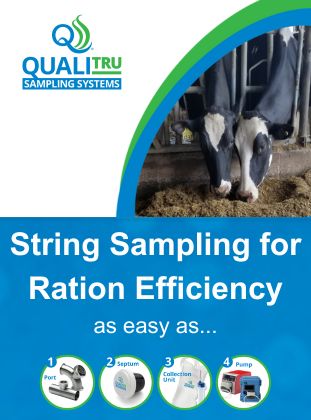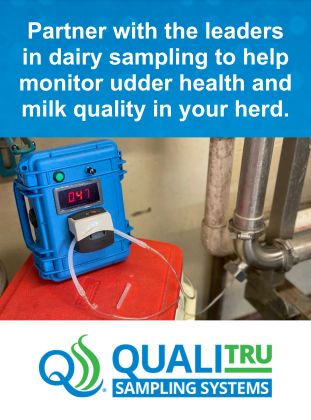Regenerative Agriculture on a Dairy Farm

By Heather Smith Thomas.
Paul and Erin Kernaleguen are dairy farmers and soil consultants near Birch Hills, Saskatchewan, committed to regenerative practices in growing forage for their cattle. They farm with Paul’s Parents, Jos and Brenda.
“We were a very conventional dairy operation until 2012 when we started looking at doing some things differently because our weather was super-wet for a couple years. Our average annual precipitation is about 12 inches of moisture, but we’d had two years in a row with about 40 to 50 inches, which made farming extremely difficult!” says Paul.
As dairy farmers, they usually planted corn and barley for silage, but those crops kept drowning out. “We looked for something else and planted an oat crop. Once we started looking for different options, it started us down the path of using different blends and polycultures for forage,” he says.
“For our first trial with a polyculture, we used barley, oats and peas planted together. We didn’t add any fertilizer because the peas (a legume) would fix nitrogen. Back then we were spending about $250 per acre trying to grow corn. With the blend, our inputs were about $30 per acre.”
“We didn’t know if it would work, however, so we only tried it on 50 acres. It did work; we harvested about 16.9 tons per acre—and we hadn’t been getting any corn that would yield close to that, even on good years.”
After that, they turned the whole farm into polyculture cover crops, and never looked back. Since then they’ve used different blends that they could seed for different groups of cattle—to fit their specific diet needs. Instead of seeding several different mono crops and then mixing them together in a TMR to feed, they grew these all together as one crop. The cost savings have been significant; they had lower inputs, strong yields and high nutrient value in the feed.
“Even our lactic acid levels in the silage have been tested and are higher than any of us thought possible. In the past we seeded barley, corn, and alfalfa and harvested them separately. When it was time to feed the cows, this meant going around to three different silage bags and creating the mix. So we decided to seed it all together, and called it seeded TMRs, to feed to different groups of cattle,” Paul says.
“When growing the protein and trying to achieve close to the requirements for the different groups of cattle, we were saving quite a bit of money. It is a huge savings on feed costs. The farm is more self-sufficient with what is being grown. That’s a plus, on growing the feed, but there have also been benefits in animal health and production,” says Paul.
“We used to be a high-production herd. We had mid to high 40’s in production and everything was going well, with about 3.5 to 3.75% butterfat in our herd of purebred Holsteins, which is considered very good. However, we always felt we were red-lining them, pushing them to the maximum on production.”
The TMR ration was about 60% concentrate and 40% forage, trying to get maximum production, but after switching to the multi-species silage it is now the opposite—about 60% to 70% forage and only 30% to 40% concentrate. “We have lost some production, but the butterfat is consistently higher. We now have healthier, well-conditioned cows that are producing more butterfat per cow.
During those two rainy years, we were farming around potholes and a lot of slough ground and didn’t have as much production. So we did some different things, like broadcasting seed for varieties of tubers like radishes and sugar beets that could grow around those edges and help dry up the sloughs and gain more land. Our dairy had gotten to the point that we were looking for more land, to expand a bit, but rising land prices made that impossible,” he says.
The next option was to improve on what they already had.. With innovative seeding, they went from farming 188 to 210 acres every year to farming more than 500 acres. By using the 5 soil health principles, they were able to make more of their land productive. Those 5 soil health principles are: 1) Soil armor; keep the soil covered, with no bare ground. 2) Minimize soil disturbance with reduced/no till practices on cropland and adaptive grazing strategies on grazing lands. 3) Increase plant diversity; rotate crops and include warm and cool season grasses and forbs in pastures. 4) Keep living roots in the ground all year. 5) Integrate livestock grazing.
“We went to zero till the year after we experimented with a polyculture on the first 50 acres. We got a little 750 John Deere no-till and probably everyone thought we were crazy; we went from a big air seeder to a 15-foot no-till. Improvements in the soil have been fantastic. Our soil tests from 2012 showed our organic matter was about 6.9 to 7.2 because our area is high in organic matter naturally, but when we tested in the fall of 2019, the field that had been in polyculture the longest (the first 50 acres we tried) had 12.2% organic matter,” he explains.
“Kevin Elmy (Friendly Acres Seed Farm at Yorkton, Saskatchewan) has helped us more than anyone. He has been involved in cover cropping for more than 20 years and he became our mentor. He has been a huge help as we started traveling this path. Now we are also part of a group of likeminded people, calling ourselves the Dirty Dozen. The 12 of us are either neighbors or went to school together and we all go to the same conferences on soil health and cattle marketing, etc. We’re all in our 30’s and 40’s and this group has been a great place to bounce ideas around and grow together,” he says.
“The importance of something like this is huge. If you are the only one in your region who is trying something different, you always wonder if you are doing the right thing”
Having a group of people who are all in this together is a big help. “We talk to each other nearly every day about any of these topics and new ideas, and what’s working and what’s not. This is the reason we’ve all made it this far,” he explains.
Erin says that one of the things they started during COVID was zoom meetings. “During COVID, every Sunday evening we had a zoom call, Each month we select a different topic and bring in guest speakers. We also have a mentor for that month, to walk through skill sets of those different areas, and everyone can bring various ideas or challenges or questions to the table and get some information. Kevin Elmy was a mentor one month, talking about soil health,” Erin says.
Another new direction for Paul and Erin is direct marketing. “We had started doing this, but ramped it up even more after COVID. When the pandemic first started, I didn’t think it would affect us much, but then a person could only buy a certain amount of milk and meat at the grocery store. There were limits on various things and it was just crazy,” he says.
“This has been a rewarding experience, getting to explain to new customers who we are, what we do, how we raise the animals—the fact we are not feeding them corn, etc. We hope to pass along some of the soil health benefits with healthier animals and healthier meat and milk. We are seeing the improvements in our fields go right on to the food that people are eating. This has all accelerated because of COVID,” he explains.
They also sell a little pork. “When COVID first started, we had to dump milk because the milk processors were not set up to supply that much to grocery stores; they were used to supplying more wholesale to restaurants and bigger consumers. So in the beginning there wasn’t a processing line for that amount of quantity to individual consumers at the grocery stores; we bought pigs to utilize some of the excess milk rather than waste it,” says Paul.
Another unique thing about Paul and Erin’s farm is their vermiculture program. “Kevin said, ‘if only we knew somebody with extra space, year-round heat and byproduct (manure) from the cattle’ and I thought this was a great idea and said we ought to get worms. I bought one yogurt container of worms from a lady in town who grows them in her basement,” Erin says.
“We are now growing our worm composting project. Saskatchewan has a vermicomposting website where you can get resources and information. I put my name on there, to mention that people can get worms from us. She and Paul hope to put worm juice in their fields, right into the seed furrows, because research has shown good results.
We now joke that this was one of the most profitable products from our farm!” she says.
Another project is selling forage seed. “Kevin is a consultant for Imperial Seed since he knows so much about cover crops. Now we work with Imperial to do some of the sales and support for other producers. We help people design cover crops and custom poly blends for specific purposes—whether for grain farming, cattle grazing or silage.”
“The first year, Kevin helped us with every blend and double-checked everything; this was a great transition for us to take on this role and help other people experience some of the successes we’ve experienced. The cover cropping really changed our operation a lot,” Paul says.
Erin points out that what they do with the seed business is custom designed for each farm. “It takes time, to adjust blends according to each person’s needs and goals. Kevin put it together but we have an assessment form on our website for people to fill out and start thinking about what their objectives are and what they are trying to do, and their resource concerns.”
Paul and Erin are happy to answer questions, or help people get started on a different path toward better soil health. Erin does instagrams and Facebook telling about their farm life and the website, which is www.kattlesquared.com . “There are various things that we’ve taken on, to help support the industry and ourselves,” Erin says.
Their Facebook and instagram: @kattlesquared



